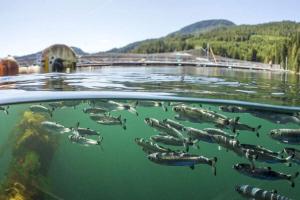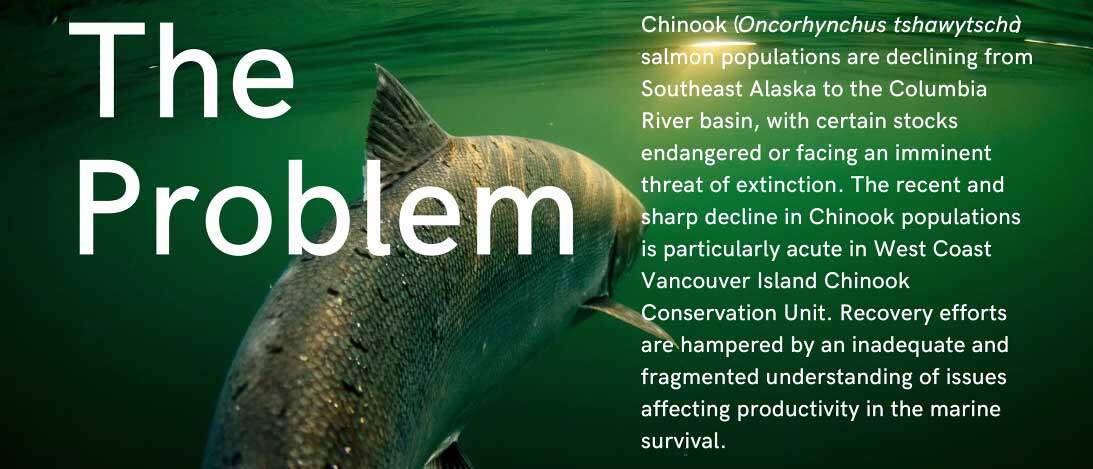Image Credit: Clayoquot Salmon Roundtable
The loss of local salmon stocks on Vancouver Island spurred the formation of the Clayoquot Salmon Roundtable in 2013. The Clayoquot Salmon Roundtable consists of representatives from the Tla-o-qui-aht, Ahousaht, and Hesquiaht First Nations, Federal and Provincial government agencies, NGOs, aquaculture, sport, recreational and commercial fishers and other stakeholders. The purpose of the Roundtable has been to build partnerships in co-management processes aimed at the recovery and protection of Clayoquot Sound’s wild salmon stocks. Friends of Clayoquot Sound sits as a watchdog of the science and the decision making process.
Since 2020, the first ever Marine Risk Assessment (MRA) for wild salmon has happened slower than initially hoped due to the COVID pandemic. However, the objective to identify and rank the limiting factors in the marine environment and causes for the rapid decline in wild salmon stocks has remained. In 2022, the MRA process involved 10 days of scientific presentations to identify high risk factors, key data gaps, and most importantly – to develop a strategy for stock rebuilding, restoration, mitigation, and management. These are some of our takeaways.
Deadly Parasites: Salmon Farms Provide Ideal Breeding Conditions for Sea Lice
The Marine Risk Assessment confirmed that sea lice impact the performance of juvenile salmon, as 3 sea lice can be deadly for a smolt. The presence of open and semi-closed salmon farms in Clayoquot Sound functionally act as breeding laboratories for sea lice. Exposure to sea lice from salmon farms increases the risk of stress, poor fitness and performance, disease and mortality, because juvenile salmon must live among salmon farms during the first 2 years of their life before they migrate offshore. Dr. Tony Farrell’s presentation to the Clayoquot Salmon Roundtable rightfully questioned if Canada’s Department of Fisheries and Oceans (DFO) current threshold of 3 lice per fish, before mitigation is required, is a “stable strategy”.

Sea lice infestations are deadly to juvenile wild salmon. Monitoring in Clayoquot Sound in recent years revealed 70-100% infection rate during the sensitive out migration period. Credit: Mack Barlett
Currently, when salmon farms exceed DFO’s 3 sea lice limit, the corporation responsible is given a 7 week grace period to bring down the sea lice count. This is often during the critical juvenile salmon outmigration to the ocean. As Dr. Alexandra Morton emphasized to the Clayoquot Salmon Roundtable, it is accomplishing nothing to allow farm operations to stay above the already high sea lice threshold for 42 days. There is also no point for DFO to only maintain the threshold seasonally, when juvenile salmon are in the near shore marine environment year round. And if removed sea lice are being dumped back into the marine environment by corporations, many sea lice survive to reinfect again. Therefore, no mitigation to protect wild salmon is effectively taking place. Besides all of this, sea lice treatments have no proven long term efficacy – and sea lice may be gaining resistance to enhanced chemical treatments, the toxicity of which also threatens the health of salmon.
Deadly Viruses, Bacteria, and Diseases: Salmon Farms Factory Conditions Increase Spread
Piscine orthoreovirus (PRV), found in 80% of farmed Atlantic salmon, is known to cause heart and skeletal muscle inflammation and hemorrhages in internal organs in salmon. Dr. Kristi Miller Saunders documented the PRV disease agent more than a decade ago in B.C. The virus causes jaundice and anemia in fish and is associated with organ failure in Chinook. Additionally, Tenacibaculum maritimum (TM), a bacterium which produces mouth rot, is affecting Atlantic salmon in farms all over the B.C. coast. TM presents with lesions on the upper and lower jaws, making it difficult for fish to feed. In wild salmon, the bacterium can cause a disease called Tenacibaculosis. Over time TM can reoccur in salmon populations and mortality rates can reach 30%.

Juvenile wild salmon swim past a salmon farm putting them in the danger zone for sea lice, toxins, and infectious diseases. Credit: Tavish Campbell
Exposure to pathogens from salmon farms including PRV and TM increases the risk of disease to wild salmon as all juveniles have to pass through and live among the salmon farms located near shore for their 1-2 years before they migrate offshore. When considering pathogens, the current nearshore locations of salmon farms could be comparable to us humans situating open air infectious disease wards (or COVID screening centers) on the main routes of children walking to elementary schools. From the perspective of a precautionary fisheries management, wild stocks demand salmon farm locations on migration routes be removed immediately. This reality cannot be solved by semi-closed systems in the near shore either as the water columns are all mixing with the swells and tides in the near shore.
The Solution: Remove Salmon Farms from the Ocean ASAP
We can keep measuring the impacts until the salmon literally don’t come home. DFO has the responsibility and power to implement precautionary, adaptive management so that wild salmon can actually benefit. Every year the salmon farms are left operating, especially in the near shore (which is where salmon farms are in Clayoquot Sound), the viability of the wild salmon stocks decrease. Considering the vulnerability of juvenile salmon, what would present a higher risk than the current nearshore locations of the salmon farms on juvenile salmon migration routes?
The nearshore locations have no doubt been selected for the operational economic benefit of the aquaculture industry, but at the cost of the ecosystem –- wild salmon specifically. Decision makers who greenlighted the existing salmon farms on the west coast, may not have known what we know now. Renewing salmon farm licenses is a deadly threat to wild salmon. The only solution is to get salmon farms out of the marine environment as quickly as possible. When we know better, we must do better.
